Before we begin, I’d like to talk about a topic that’s a little stale by now. Sorry, but this is my first chance to talk about it! You see, I submitted my last column 16 days ago. 15 days ago, Meghan Wolff posted an interesting discussion on concrete steps that could be taken to improve women’s participation in the game at the higher levels of competitive play. 14 days ago my last column posted, without giving me the opportunity to throw some positivity Meghan’s way. Then, 11 days ago Jim Davis was briefly given a platform to discuss the issue of gender in Magic, and the first sentence that wasn’t given over to a recap of a South Park episode read: “Why is it that often articles written by female Magic players end up being about females playing Magic?”
If you’re interested in my full perspective on that article, you can find it here. In the meantime, I have two points.
First off, when a person calls a woman a “female” it makes them sound like a Ferengi. That’s not a good look. If you commonly find yourself using that language instead of women or ladies (or even girls, if talking specifically about young women), I’d suggest spending some time in reflection on why you’re primarily comfortable talking about women in the most clinical terms possible.
My other point is that I’ve been writing for SCG about a year now, and I’ve never devoted a column on this site to talking solely about the social politics behind creating a welcoming game environment. I’ve talked about it elsewhere, but even there it’s in the context of years of content. If people like Jim Davis think women are only talking about ladies in Magic, it’s not because woman-created-Magic-content isn’t out there.
Anyway, this week’s submitter caught my eye with a Commander of whom I’m quite fond: Selvala, Explorer Returned. Let’s read!
Dear Azami,
I’d like to parley with you for a moment.
I just can’t seem to get the balance of this deck right. My commander is Selvala, Explorer Returned. I started with a combo deck using Umbra Mantle and Mana Reflections and as many untap effects as I could fit. But soon everyone started to focus on me, and it was getting tiresome to do the same thing every game. So I tried to make it more of a prison/control deck by protecting a Peacekeeper or Blazing Archon, but people would get bored of the long, drawn-out games that I started to cause. So I tried being more of a gifting, casual deck. Which, while more fun, made me feel very weak and at the mercy of everyone else I sat with. Now the deck is a mix of everything and Selvala has a bit of an identity crisis on her hands.
I want to utilize Selvala, Explorer Returned in a fun and crazy way. I really enjoy the Join Forces cards and utilizing the drawbacks on cards to help the weaker players. I want this deck to be competitive but also make games enjoyable for everyone playing. I have quite a few random hate cards and underwhelming cards that tend to do nothing but rot in my hand or sit in play doing very little. I have no idea where to go with the deck. Hopefully you can find a way to make this deck both fun and powerful. I like to splurge a bit, so have at it!
Commander: Selvala, Explorer Returned
Alliance of Arms
Angel’s Grace
Archangel of Thune
Aura Mutation
Aura Shards
Back to Nature
Bant Panorama
Bargain
Beacon of Immortality
Benevolent Offering
Blazing Archon
Blessed Wind
Blossoming Sands
Collective Voyage
Command Tower
Constant Mists
Courser of Kruphix
Dauntless Escort
Day of Judgment
Deathrender
Eladamri’s Call
Elesh Norn, Grand Cenobite
Eternal Witness
Entreat the Angels
7x Forest
Gavony Township
Ghostly Prison
Graypelt Refuge
Hunted Lammasu
Hunted Troll
Hydra Broodmaster
Knight of the Reliquary
Kor Haven
Krosan Grip
Krosan Verge
Maze of Ith
Mirari’s Wake
Mikokoro, Center of the Sea
Naya Panorama
New Frontiers
Novablast Wurm
Nullmage Advocate
Oracle of Mul Daya
Path to Exile
Peacekeeper
9x Plains
Polukranos, World Eater
Reflecting Pool
Refreshing Rain
Reliquary Tower
Reveille Squad
Rhox Faithmender
Rousing of Souls
Sakura-Tribe Elder
Seedborn Muse
Selesnya Guildgate
Selesnya Sanctuary
Serra Ascendant
Sol Ring
Solemn Simulacrum
Soul Conduit
Soul Warden
Soul’s Attendant
Spike Weaver
Spurnmage Advocate
Sun Titan
Sunpetal Grove
Storm Seeker
Swiftfoot Boots
Sword of the Paruns
Swords to Plowshares
Temple Garden
Temple of Plenty
Temple of the False God
Tempt with Discovery
Tolsimir Wolfblood
Truce
Ulamog, the Infinite Gyre
Vitu-Ghazi, the City-Tree
Well of Lost Dreams
Windswept Heath
Wirewood Lodge
Worship
Wrath of God
Yeva, Nature’s Herald
Thank you,
Jeremy
When a deck evolves multiple times in succession, it often loses the thread. I have this problem all the time: you try to shoot for the new archetype but end up leaving in pet cards, or cards that seem absurd to cut. As time goes on, this means that your deck provides less of reliably-pleasant experience to play.
And this goes double if you’ve been forced into evolution thanks to sustained aggro on the part of your usual playgroup.
My solution for this specific deck was twofold. First, I added in the other Parley cards. It seems like you’re pretty solid on Parley as a mechanic, and I think the other three are just as good as Rousing of Souls. Second, I took the additional Parley cards, which include two token-makers and a battle anthem, and turned this into a broader token theme.
This already fit with some of what I was seeing in your deck, specifically the Soul Sisters side of the lifegain theme.
To make room for this, I made a fair number of cuts. Some of the cards I took out are quite powerful. Others are not. My goal was to turn the deck into something with fewer answers, but slightly more draw so you’d be more likely to get the answer you were looking for when you need it.
Of course, not everything needed a change. I was a little skeptical of Maze of Ith, since it brings your real land count down to 36, which is a bit low for a typical deck. I decided to go with it, though, because you have a three-drop commander who ramps and draws cards. Plus, given the reliance on Parley, you want to have fewer “blanks” in your deck as things start to rev up.
Cut Out the Hugs
Out:
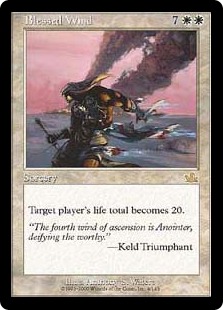
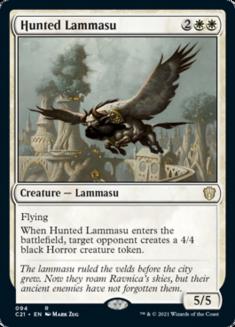
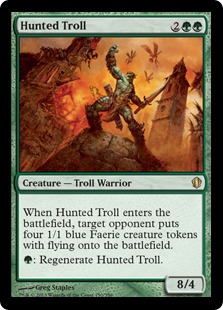
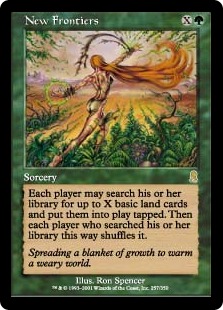
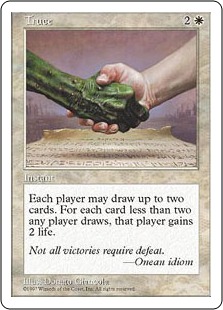
In:
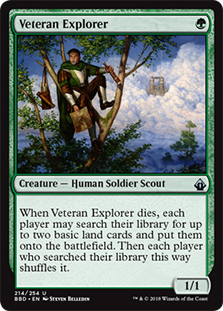
First off, in Commander I tend to dislike cards that set a player’s life total at something other than 40. I dislike Sorin Markov and Magister Sphinx for this reason, which is honestly a bit of a shame, since Sorin Markov was one of my favorite Limited bombs back in the day (when I survived to cast him, of course; Zendikar was a blisteringly fast format at times). Blessed Wind is a particularly niche example of this type of card, since unlike the other two options it doesn’t leave you with a permanent after it’s had its effect.
Plus, you know, twenty life is not the same as ten life. While you’re more likely to be able to use this as a positive for another player, given that difference, it’s still not the strongest card.
The Hunted creatures were the next to go. I think Hunted Troll may be the best of that odd cycle; Hunted Horror and Hunted Phantasm are contenders, but regeneration pushes the troll to the top of that dogpile. Anyway, while I like Hunted Troll, I was trying to move the deck away from the Hugs feel. This meant cutting the solid Hunted Troll, and the significantly-less-solid Hunted Lammasu, which would be unplayable in Commander were it not for the drawback.
That whole cycle is one of the weird ones where the drawbacks make cards that are otherwise too vanilla for Commander play into fair game. If you can think of others, hit up the comment section!
New Frontiers is the weakest of the friendly ramp spells. While I tried to keep the more powerful Hugs cards in the deck, to save the spirit of the thing, New Frontiers was just too weak to keep. Each of the others offers an opportunity to gain early advantage from the spell, but New Frontiers taps you out for an advantage you don’t get benefit from until your next turn. You can use Collective Voyage as a Rampant Growth and end up getting more than one land for your investment; the best rate of return on New Frontiers is probably three lands for five mana, and that’s a dangerous amount of ramp to let everyone else get the first use out of while you’re tapped down.
Veteran Explorer offers immediate advantage, since the lands come into play untapped, and it’s also a fairly effective chump-blocker. Those are two things that New Frontiers just can’t do, and it costs less to boot.
Cut Out The Aggro Magnets
Out:
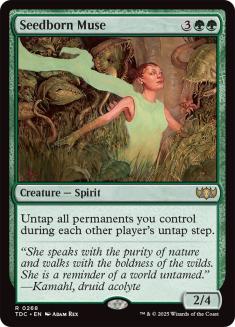
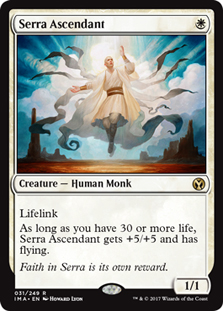
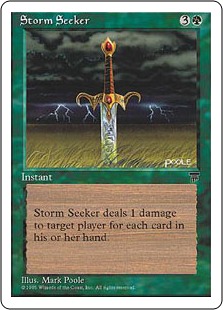
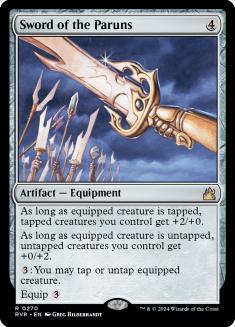
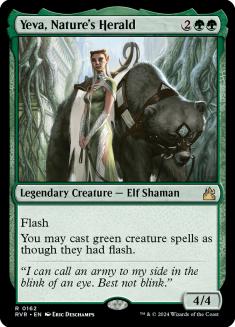
Taking extra turns in Commander is notoriously impolite. In effect, taking an extra turn means making each of your opponents skip their next turn, and as such it has a corrosive effect on the group’s collective fun. For this reason, many playgroups have social pressures, and occasionally even house rules, that bar blue decks from doing something that’s a fairly major piece of its color identity.
Seedborn Muse is basically a “take all the turns” spell, especially combined with a card like Yeva, Nature’s Herald. While this version doesn’t cause your opponents to skip their turn like the blue ones do, what it does is rob their turns of their ownership. Now, that moment of attention and focus gets split between the Seedborn Muse player and whatever unlucky sod happens to have their turn at that moment. It’s unpleasant, and it’s powerful, and it’s going to put you under the crosshairs… particularly when paired with a commander who can draw you cards and ramp you during each player’s turn.
Sword of the Paruns raises the specter of an infinite combo without promising to deliver it. That’s the type of thing, particularly in a Selvala deck, that draws the attention of the table. Any goodwill you’ve accrued by letting your opponents draw cards is going to be wiped out once they see a recipe for their immediate death. And again, it’s a specter that isn’t often going to make good on that combo, since the chances of you hitting at least three spells on every Parley seems unlikely (unless you’ve New Frontiers-ed their decks out again… and I cut New Frontiers). It’s a bad ratio of threat to action, and for that reason Sword of the Paruns ends up in the dustbin.
Storm Seeker is another example of that bad ratio in play. If you’re forcing your opponents to draw a lot of cards, Storm Seeker provides you with an opportunity to dome a single other player for a fair chunk of damage. However! There’s a reasonable chance, given the Parley and Courser of Kruphix and whatnot, that your opponent sees the Storm Seeker coming. And in that case, if a player’s in a position where that Storm Seeker is a threat, they’re going to come after you hard.
It’s kind of like slapping your opponent in the face. It doesn’t do a whole lot of overall damage, but it’s straight-up infuriating. Generally, that’s the type of effect you want to avoid.
Finally, there’s Serra Ascendant. It may seem odd that I explicitly called out Soul Sisters as a part of the deck that I liked while cutting a card that’s often played in Soul Sisters, but there’s a method to my madness. Here, it has to do with that threat ratio. A turn-one Serra Ascendant in Commander can be quite a threat. Usually there are few people with defenses at that stage in the game, and what defenses people do have rarely manage to handle a 6/6 flier with lifelink. But it doesn’t kill people fast enough. By turn four or five, you’ve managed to knock a single player down to a low life total, but you’ve earned that player’s enmity and are now facing down a table full of players pissed that you’re at 70 life.
Basically, don’t play Serra Ascendant in Commander, period. It’s only really worth it in a White Weenies aggro shell (commanded by Thalia, Guardian of Thraben, typically), and that deck’s a little too Legacy for most playgroups.
Dial Back the Protection
Out:
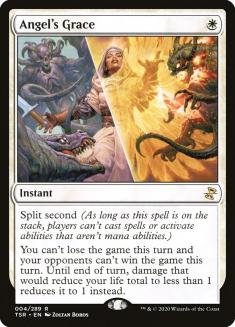
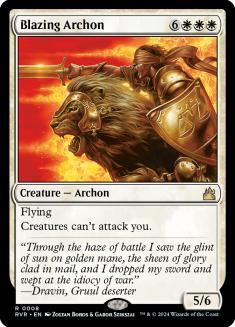
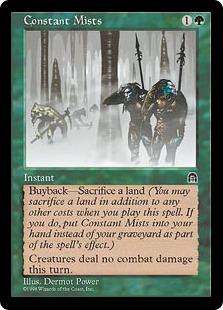
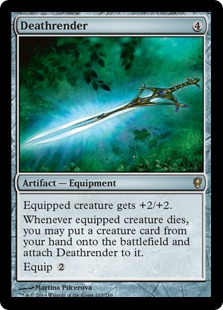
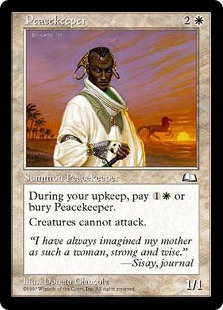
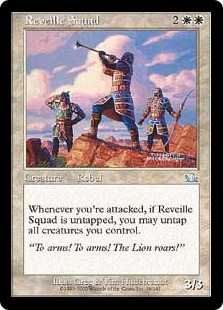
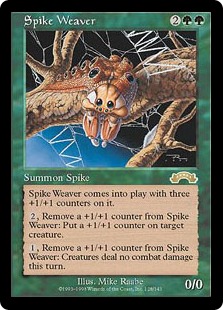
In:
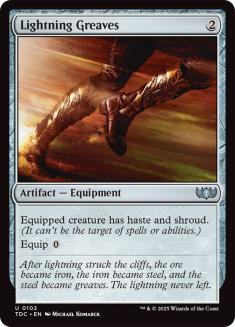
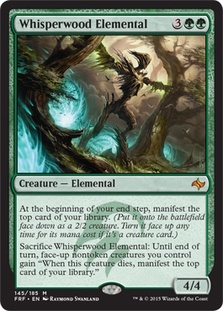
From the letter, it sounded like Jeremy had to add many of these cards due to too much negative attention from the rest of the table. Unfortunately, these cards defend without adding a significant amount of value. They’re strong, but they’re not good rattlers.
Well, all but Reveille Squad, that is. I had to look this one up, which is a rarity. I’m glad I did, as it seems like a pretty neat card in a Tribal Humans deck or something to that effect. In here, the card is weakened by the adoption of the token subtheme. Tokens are, in general, less robust than most of the other bodies you’ll typically find on the battlefield. As such, you usually don’t want to attack in the same way. Reveille Squad draws more attention to when you choose not to attack, because you have few reasons not to attack when it’s on the field. So, if you’re trying to subtly build up board position, Reveille Squad will likely draw attention to that fact. Meanwhile, relying on it for defense means being certain your opponents don’t have removal for it. I don’t know if that’s a safe bet, since a 3/3 white creature dies to basically all of the spot removal spells that see play in Commander.
Blazing Archon and Peacekeeper both struggle from the same issue as Reveille Squad: they’re inconveniently vulnerable to spot removal. I first became familiar with Peacekeeper from playing Living Wish Elves in Legacy. In that deck, it rode in the sideboard for other creature matchups since the upkeep cost meant you could let it die when you were ready to go off. In Commander, it’s a hate card, which draws attention; it fundamentally changes one of the base elements of the game, which is frustrating to anyone whose deck plans to attack; and it’s very vulnerable to spot removal. What this means is a bullseye on the card that is keeping the aggro off you, and that’s a little counterproductive as these strategies go.
Blazing Archon has far fewer of these issues, as it only restricts your opponents from attacking you, and it has a body that can tangle. It’s also a nine-drop. If you’re making it to nine mana, it’s rare that you need an effect like this. The Archon shines in reanimator strategies, where you can cheat it out for far less mana, but in a fairly straightforward deck like this one it’s not a strong enough line of defense.
Angel’s Grace strikes me as being more of a combo card. As-is, all it does is delay your death by a turn. I imagine this is one of those cards that spends a lot of time in your hand since it has no utility unless you’re in mortal peril. Since it’s generally better to avoid said peril, I think it’s a fairly safe cut.
Constant Mists and Spike Weaver are both Fog effects, and those are iffy in Commander. If you need that effect, better to get it from a card like Safe Passage, which both protects from noncombat damage and has some teeth. Spike Weaver offers neither of these things, because other than being tapped out, Fog doesn’t punish an opponent for their attack. Spike Weaver buys you three turns at best, and Constant Mists has one of the more punishing buyback costs around, even if you do have a Knight of the Reliquary. I think it’s safer to just cut these and experiment with more proactive protection.
Proactive protection looks a lot like Whisperwood Elemental. That card offers a way to save a fair chunk of your team while adding to the board each turn it manages to avert death. That would be good in a random deck; in a deck where you have some knowledge of the top of your library and some ability to affect what’s there, it downright shines.
Lightning Greaves looks less like this, but with a commander like Selvala, Explorer Returned, the benefit of being able to use that ability the turn she comes into play is well worth being unable to target your own creature.
Dial Back The Removal A Scooch
Out:
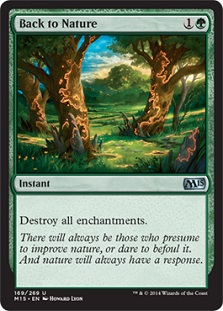
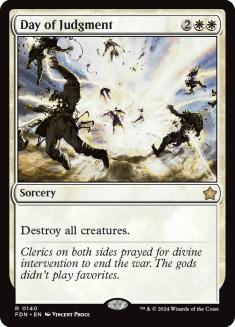
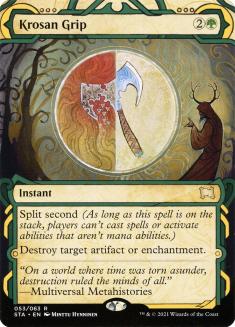
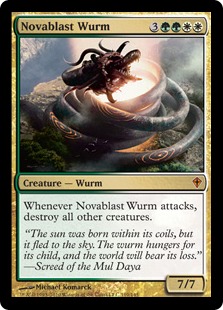
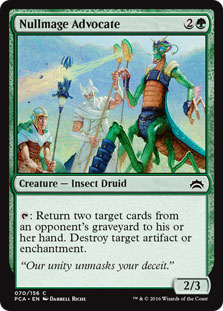
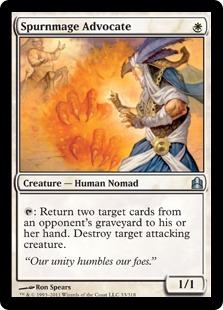
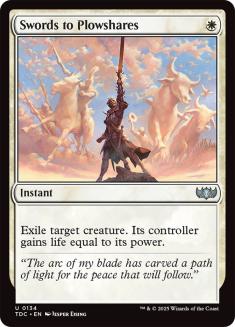
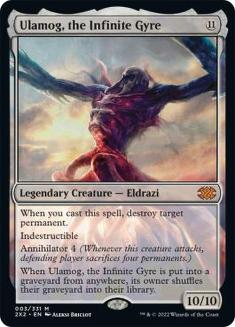
In:
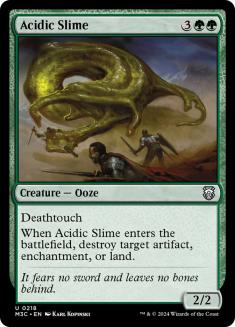
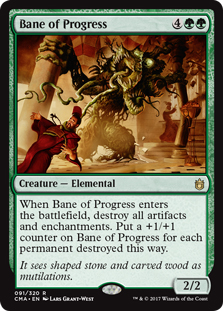
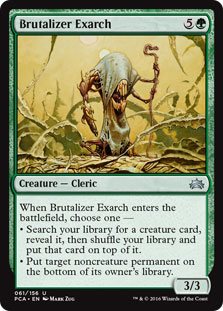
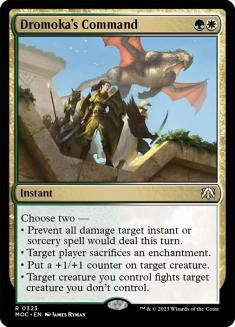
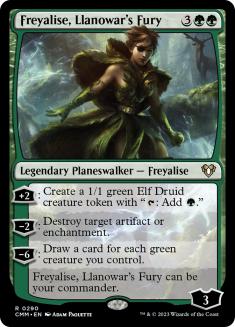
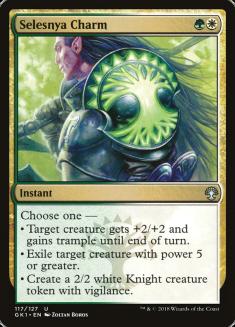
For what it’s worth, I think there’s a deck out there where this is the right removal suite. None of the cards I cut in this section are bad, but given the more creature-centric direction I’m moving the deck, it no longer seemed like they fit. Back to Nature, for example, is a fairly specific card; replacing it with Bane of Progress gets a similar effect, but now you’re trading four mana and a slower speed for a broader range of permanents destroyed and a body that knows how to dance. If Back to Nature was the type of card you wanted to play on turn two, I could see that four mana being a deal-breaker, but these types of mass removal spells tend to do more damage the longer you hold them back. By the time you really want to be using this thing, six mana no longer seems like an unreasonable cost.
Day of Judgment and Novablast Wurm are both good versions of Wrath of God, but they’re not as good as the original. As a whole, I wanted to move away from Wrathing as a regular strategy since the token theme requires a bit more commitment to the board, but every once in a while it is nice to have a Wrath. So I compared all three and then kept the best one in there, cutting the other two.
Krosan Grip is great in Legacy, where counterspells rule the roost. In Commander, it’s a little weaker. It’s a one-for-one removal spell, which is weaker in a format built around card advantage. It’s uncounterable, but that’s less of a consideration in most situations; usually, if there’s only one artifact or enchantment on the board you need to take out, it’s not being defended by the blue player. Instead, I like playing a card like Freyalise, Llanowar’s Fury in this slot. Not only is she a repeatable Naturalize effect, but she also lets you create tokens that ramp and she draw cards. That’s a lot of options, and those are the types of decisions that make for an interesting turn.
The same goes for Swords to Plowshares, by the way. I don’t think you need more than one unconditional removal spell in this deck, and of the two of them I think Path to Exile actually meshes better with Parley.
Nullmage Advocate and Spurnmage Advocate are both cards I quite enjoy, even outside of Hug decks. They tend to be great political cards, and they both have the type of ability that you don’t feel obligated to use every turn. However, they’re both a bit slow, and we’re moving away from the Hug-deck feel. I cut them in favor of Selesnya Charm and Dromoka’s Command since those cards can do a wide variety of things without any drawback.
Side note: if you enjoy those two Advocates, try playing with Pulsemage Advocate sometime. That card can be ridiculous. It’s best in a deck like Thalia, Guardian of Thraben, where the thorn in your opponents’ side keeps them from casting all the fuel you’re giving back, or in a Living Death deck, where getting cards out of opposing graveyards is a net positive. It’s not for this deck, but in the right setting it shines.
Finally, I cut Ulamog, the Infinite Gyre. I imagine this decision will be seen as heretical, but hear me out! Ulamog draws way too much aggro, and Annihilator is one of the least pleasant abilities to play against. I actually think Kozilek, Butcher of Truth is a better card for Commander, since its huge size and lower casting cost are balanced out by it dying to common removal. In general I try to shy away from Eldrazi, because it really isn’t a pleasant feeling to harass an opponent’s manabase (and that’s what Annihilator really does), but if you are running one I don’t think Ulamog’s the pick.
I also added in Acidic Slime and Brutalizer Exarch to round out the removal suite. Each one of those can kill a variety of permanents and comes attached to a body with upside. For Acidic Slime, that upside is being a fairly effective defender, as few people will attack you if you can trade your spent Mulldrifter for their best attacker. Brutalizer Exarch has a worse body, but it’s flexible in a way that works really nicely with Parley and other library manipulation.
When crafting a strong removal suite, flexibility is my watchword.
Change Up The Lifegain
Out:
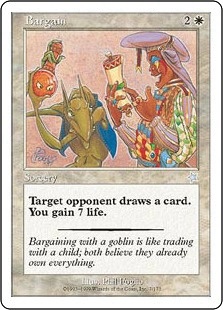
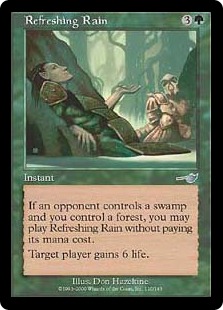
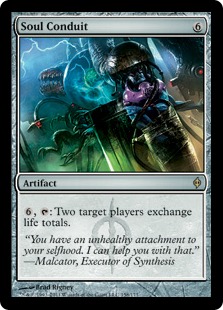
In:
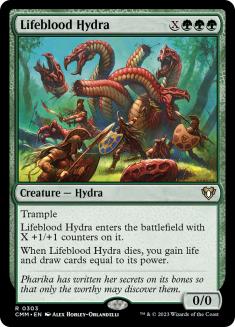
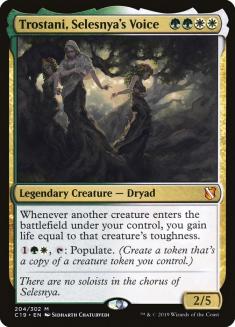
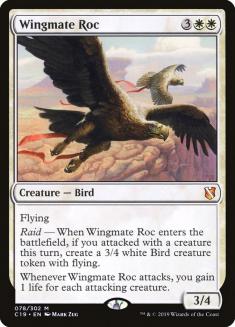
Pure lifegain spells are bad in a format where you begin with 40 life. Even something like Beacon of Immortality, which is basically the best pure lifegain spell available in the format, suffers from its inability to affect the board. Soul Conduit is neat because you can use it to switch the life totals of two opponents, but that draws more attention than it’s worth since switching life totals is the type of change that irritates more than it eliminates.
Instead, I brought in several creatures. Lifeblood Hydra is a piece of beef that replaces itself when it dies, in the form of life and cards. Since it’s scalable, it’s the perfect type of play to line up with Selvala; even if you don’t hit on every library, you don’t have to worry about wasting mana the turn you cast it. Typically I’m not a huge fan of Hydras, but this is one of the better versions.
Trostani, Selesnya’s Voice is being added to assist the token theme, but on the ground she’s going to primarily be working as another Soul Sister. This one trades the ability to trigger off your opponents’ creatures for more life per trigger, and when you’ve already got cards like Rhox Faithmender in the deck that can be an acceptable trade. Also, if you have Trostani in play and resolve Rhox Faithmender, you gain ten life, which is a fair chunk of change. All that and she can Populate too!
Finally, there’s Wingmate Roc. A token deck that likes to gain life is the perfect place for Wingmate Roc. It rewards you for going wide, and it’s fairly easy to get a Raid trigger when you can throw some fodder at an opponent without great concern as to whether the token lives or dies. Then, if you get Trostani (or any other Populate effect) online, a 3/4 flying bird is a pretty good token to start photocopying.
Add Some More Draw
In:
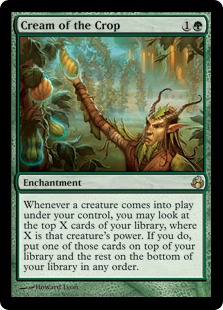
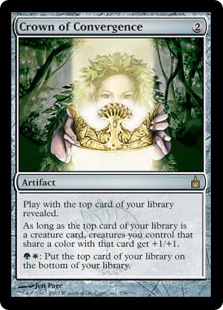
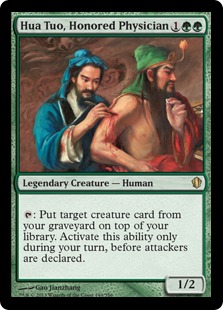
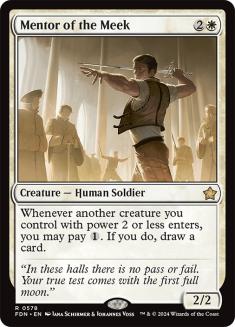
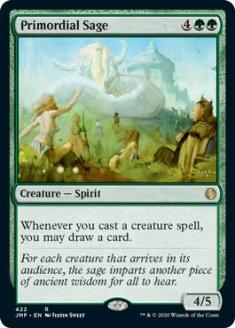
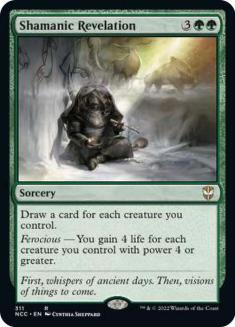
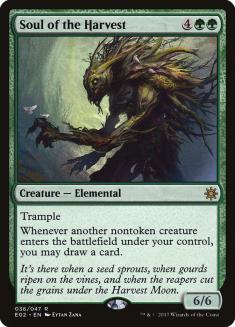
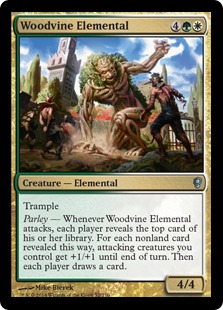
We have reached the point at which all further changes are net gains. We cut away the relics of old themes, and now we have room to cultivate fresh growth. In this case, step one is to fertilize the soil… appropriate, given that this metaphor has spiraled into BS.
Seriously though, step one is to add draw engines. That’s almost always the first step when upgrading a Commander deck since the worst thing that can happen in a deck is running out of fuel, and this is even truer when your deck incentivizes over-commitment to the board. Here I have lumped together the actual draw engines alongside the pseudo-draw engines, but they’re both very relevant for what the deck wants to do.
First, let’s talk about the pure draw, since those cards are less interesting. Mentor of the Meek loves token decks since many of your tokens have one or two power, and that means you can draw more cards. Unlike Soul of the Harvest, Mentor can trigger on tokens. Soul’s still worth playing, mind you; even when it’s drawing you few cards, it’s still a 6/6 trampler for six mana. In this deck, though, both Soul of the Harvest and Primordial Sage should still draw you a fair number of cards due to the high creature count… although I imagine your opponents may take issue with my use of the word “fair” there. The same goes for Shamanic Revelation, which will not only typically draw a bunch of cards for five mana, it will also gain you a fair bit of life on the side.
Then there’s Woodvine Elemental. I kind of love this card. Whenever it attacks it both draws you a card and pumps your team, potentially for a large bonus. It’s the type of draw engine that does well when you’re going wide, although the inherent uncertainty will bite you at least once. Variance!
Second, though, let’s talk about the top card of your library. It turns out, when you’re focusing on Parley, being able to manipulate the top card of your library is pretty powerful. You’ve already got a few ways to do this, what with Courser of Kruphix, Oracle of Mul Daya, and the fetchlands/Panoramas. What I wanted to do was add one or two more.
Cream of the Crop lives up to its name; in any creature deck concerned with the top card of the library, it gives you an incredible degree of control. Sure, it does nothing when a 1/1 enters the battlefield, but every other creature is going to give you a choice of what card remains on top. And if you like it, you can draw that card immediately off the top thanks to Selvala. It’s a solid card, and the low mana cost means you can start sculpting your draws almost immediately.
Hua Tuo, Honored Physician works similarly, giving you control over the top card of your library which you can then choose to draw with Selvala. For Hua Tuo, the control comes by means of your graveyard. It’s good to have some graveyard recursion in basically every Commander deck, since sometimes you want to keep having fun with a card that dies. Hua Tuo provides that.
Finally, there’s Crown of Convergence. I like this one because it plays a dual role. Not only is it a means of manipulating the top card of your library, but it doubles as an anthem effect. That’s pretty handy when you’re going wide.
Make Some Tokens
In:
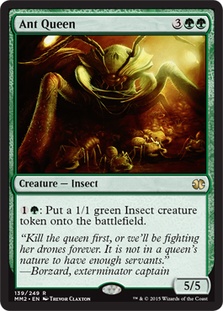
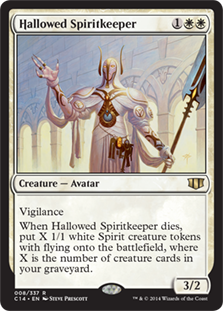
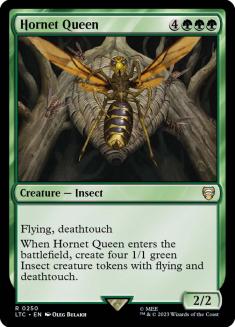
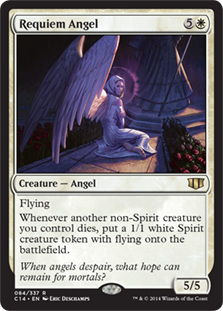
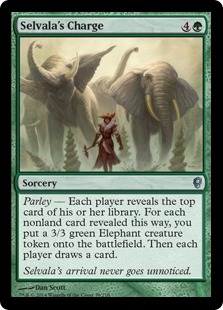
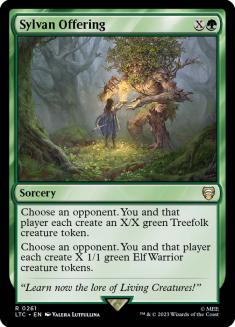
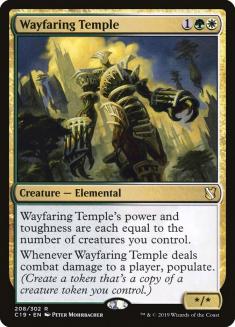
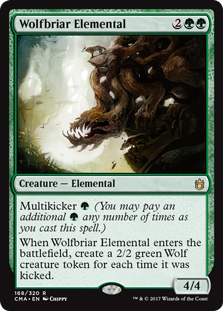
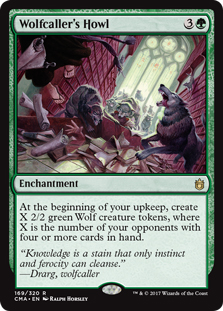
Finally, we have come to the stopper to fill that hole. Token generation is typically a bit stronger in Commander since you are often put in a position where you can trade fractions of a card off for the real thing, and that helps you get and stay ahead on card advantage. That having been said, I tried to add in token cards that work well with Selvala, Explorer Returned.
One way this materialized was through the addition of Sylvan Offering. Yes, part of why I did that is to complete the Benevolent Offering cycle, but I think it’s also a strong card on its own. The X makes it a fairly effective mana sink for your Selvala spoils, and like all the Offerings it is worded in such a way to allow for you to give one opponent the Saprolings and another the Treefolk. With that wrinkle, while it feels friendly, you can use it politically or strategically. That’s pretty cool.
As I mentioned above, I wanted to round out the Parley cards by adding in Selvala’s Charge. While it’s a little more expensive than Rousing of Souls, which is one of the reasons it’s often overlooked, the 3/3 bodies it provides are strong, especially when supported by other token enablers. In the right deck it earns its place, and this is that deck.
Wolfbriar Elemental and Ant Queen both offer a mana sink for all that green mana you’re going to generate. They’re an interesting study in contrasts: Ant Queen has the benefit of being usable at instant speed while Wolfbriar Elemental offers a significantly better rate of return for your mana. I did not include Sacred Mesa or Mobilization despite both of those cards being effective mana sinks as well. In this deck, I felt that the green mana wasn’t going to channel well through those white enchantments, so I didn’t add them in.
This is not to say I’m opposed to white tokens, and for that reason I added in Hallowed Spiritkeeper and Requiem Angel. The Spiritkeeper is good in a deck like this because many of your tokens come from creatures, and creatures are also many of your supporting effects as well. There’s a fair chance of getting a large number of tokens when this dies, and between that and the Vigilance there are times where it may as well read unblockable. Requiem Angel, however, is a personal favorite in token decks. Requiem Angel has the rarest of abilities: a token generation effect that can be triggered by the death of other tokens. While the non-Spirit restriction prevents this from being totally abusive, it’s still a tremendous amount of value stapled to a card you can easily cast off Selvala’s ramp.
Wayfaring Temple is a secondary Populate source tied to a lot of beef. When you’re going wide that body gets pretty big, and you can use it as The Abyss if you have a really good token to copy.
Finally, Wolfcaller’s Howl seems tailor-made for a Selvala tokens deck. It offers the promise of many tokens on each and every one of your turns, so long as your opponents keep moderately large hands. When you’re feeding them an extra card or two each turn off of Parley, that doesn’t seem like it will be much of a problem. Plus, Commander is a format where people draw a lot of cards with fair regularity, so even if your Parley engine gets wiped out you’re probably still going to get a couple of tokens each trigger.
The Deck
Creatures (35)
- 1 Sakura-Tribe Elder
- 1 Solemn Simulacrum
- 1 Soul Warden
- 1 Eternal Witness
- 1 Hua Tuo, Honored Physician
- 1 Veteran Explorer
- 1 Primordial Sage
- 1 Tolsimir Wolfblood
- 1 Knight of the Reliquary
- 1 Dauntless Escort
- 1 Acidic Slime
- 1 Ant Queen
- 1 Oracle of Mul Daya
- 1 Wolfbriar Elemental
- 1 Soul's Attendant
- 1 Sun Titan
- 1 Elesh Norn, Grand Cenobite
- 1 Brutalizer Exarch
- 1 Hornet Queen
- 1 Mentor of the Meek
- 1 Requiem Angel
- 1 Soul of the Harvest
- 1 Rhox Faithmender
- 1 Wayfaring Temple
- 1 Trostani, Selesnya's Voice
- 1 Archangel of Thune
- 1 Polukranos, World Eater
- 1 Bane of Progress
- 1 Courser of Kruphix
- 1 Hydra Broodmaster
- 1 Woodvine Elemental
- 1 Wingmate Roc
- 1 Hallowed Spiritkeeper
- 1 Lifeblood Hydra
- 1 Whisperwood Elemental
Planeswalkers (1)
Lands (37)
- 7 Forest
- 9 Plains
- 1 Reflecting Pool
- 1 Kor Haven
- 1 Windswept Heath
- 1 Wirewood Lodge
- 1 Temple of the False God
- 1 Maze of Ith
- 1 Krosan Verge
- 1 Mikokoro, Center of the Sea
- 1 Selesnya Sanctuary
- 1 Temple Garden
- 1 Vitu-Ghazi, the City-Tree
- 1 Bant Panorama
- 1 Naya Panorama
- 1 Reliquary Tower
- 1 Sunpetal Grove
- 1 Graypelt Refuge
- 1 Command Tower
- 1 Gavony Township
- 1 Selesnya Guildgate
- 1 Temple of Plenty
- 1 Blossoming Sands
Spells (26)
- 1 Ghostly Prison
- 1 Wrath of God
- 1 Worship
- 1 Sol Ring
- 1 Mirari's Wake
- 1 Well of Lost Dreams
- 1 Lightning Greaves
- 1 Eladamri's Call
- 1 Aura Shards
- 1 Aura Mutation
- 1 Crown of Convergence
- 1 Cream of the Crop
- 1 Path to Exile
- 1 Alliance of Arms
- 1 Collective Voyage
- 1 Swiftfoot Boots
- 1 Entreat the Angels
- 1 Selesnya Charm
- 1 Tempt with Discovery
- 1 Rousing of Souls
- 1 Selvala's Charge
- 1 Benevolent Offering
- 1 Sylvan Offering
- 1 Wolfcaller's Howl
- 1 Shamanic Revelation
- 1 Dromoka's Command

I kept together the fairly solid manabase (love that inclusion of Wirewood Lodge, by the way), and then upgraded your board presence. You’re up to 35 creatures now, and given the number of noncreature spells here that make tokens, the true number is more like 45. That’s a lot of ways to commit to the board, and a reasonable board presence typically does a fair bit to hold off attacks of opportunity.
I kept some of the instant-speed removal while supplementing it with a few versatile options; the goal there was to give you enough of a bite to force your opponents to respect that you might have removal while also keeping your deck flowing smoothly. It’s a hard balance to hit, so if it feels like you need another removal spell or two down the line, go with that. When adding removal, though, remember that versatility is key.
The Cost
Jeremy didn’t request a specific budget this week, so I kept it reasonable. I didn’t want to specifically do a budget take on this deck, but I did keep the price tags in sight, which is why I skipped cards like Austere Command. Austere Command is a solid fit in any deck where you can potentially use it as a Plague Wind while also knocking out artifacts or enchantments. Over time, however, its price has crept upwards, and I felt that you were pretty solid on mass removal options without it.
Of course, another solid mass removal option I didn’t find room for was Fracturing Gust. That card isn’t totally unreasonable, but considering its price spike was somewhat tethered to the idea of a Glittering Wish deck in Modern, I am skeptical that it’s actually worth five dollars. If you find yourself needing another Tranquility-esque card, that’s probably the one on deck.
| Card: | Price: |
| Acidic Slime | 0.25 |
| Brutalizer Exarch | 0.25 |
| Selvala’s Charge | 0.25 |
| Woodvine Elemental | 0.25 |
| Selesnya Charm | 0.45 |
| Ant Queen | 0.49 |
| Crown of Convergence | 0.49 |
| Hua Tuo, Honored Physician | 0.49 |
| Primordial Sage | 0.49 |
| Requiem Angel | 0.49 |
| Shamanic Revelation | 0.49 |
| Soul of the Harvest | 0.49 |
| Sylvan Offering | 0.49 |
| Wayfaring Temple | 0.49 |
| Wolfbriar Elemental | 0.49 |
| Wolfcaller’s Howl | 0.49 |
| Mentor of the Meek | 0.69 |
| Cream of the Crop | 1.05 |
| Hallowed Spiritkeeper | 1.09 |
| Veteran Explorer | 1.69 |
| Bane of Progress | 1.79 |
| Hornet Queen | 1.85 |
| Lifeblood Hydra | 2.19 |
| Wingmate Roc | 2.75 |
| Trostani, Selesnya’s Voice | 2.79 |
| Lightning Greaves | 6.45 |
| Dromoka’s Command | 6.59 |
| Freyalise, Llanowar’s Fury | 6.95 |
| Whisperwood Elemental | 7.29 |
| Total: | 50.01 |
As you can see, “reasonable” in this context was $50, or $50.01 if you’re a fan of precision. What was I thinking, letting it go over my arbitrary benchmark by a penny?!? Luckily, Jeremy’s out-of-pocket expenditures this week will be somewhat ameliorated by the $20 StarCityGames.com store credit received by all whose submissions are accepted for publication.
If you’re interesting in submitting to us, email your decklist and an explanation of what you’re going for to DearAzami [at] gmail [dot] com. The more interesting the submission, the better the chance of it being selected. Cassidy and I tend to pick these things based on what piques our interest, so keep that in mind when crafting your submission email.
That’s it for this week’s Dear Azami. Come back next week for another column from Cassidy, and I’ll see you again in a fortnight!
Want to submit a deck for consideration to Dear Azami? We’re always accepting deck submissions to consider for use in a future article. Only one deck submission will be chosen per article, but being selected for the next edition of Dear Azami includes not just deck advice but also a $20 coupon to StarCityGames.com!
Email us a deck submission using this link here!
Like what you’ve seen? Feel free to explore more of Dear Azami here, in the Article Archives! And feel free to check Jess’s own Command of Etiquette column on Hipsters of the Coast, for more Commander and casual content. Now on Thursdays!
